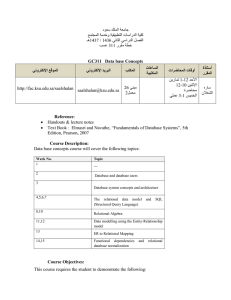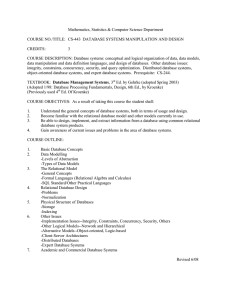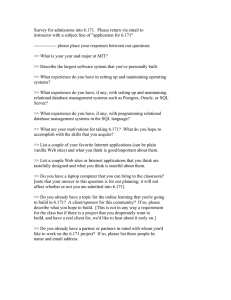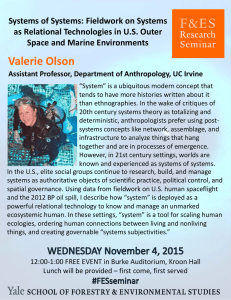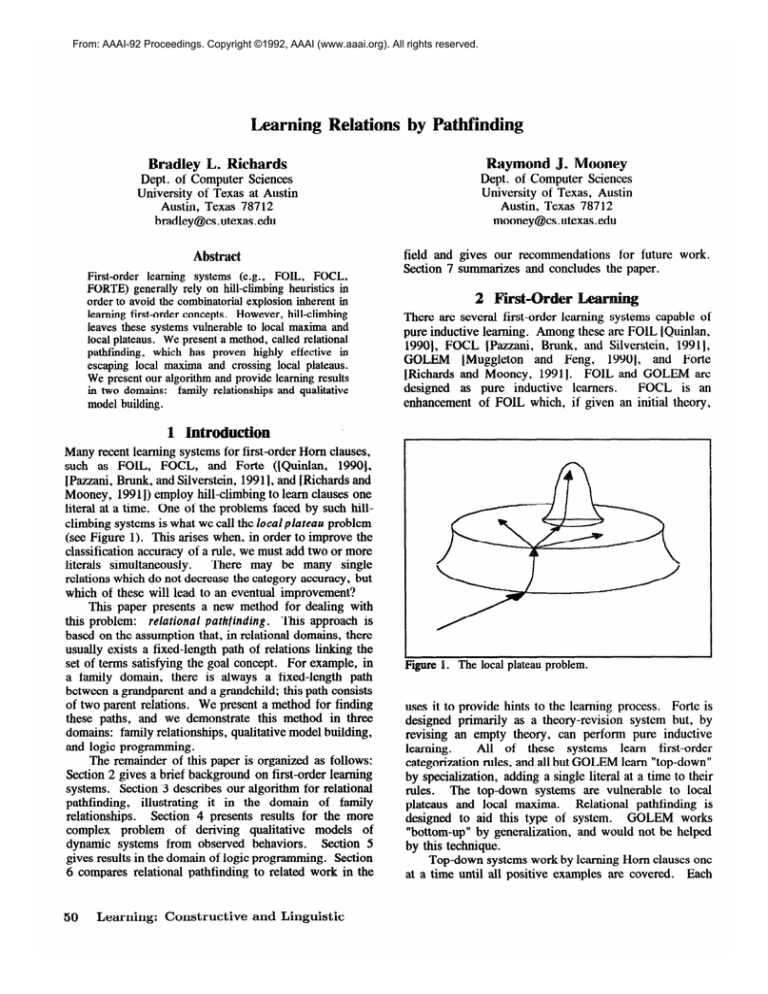
From: AAAI-92 Proceedings. Copyright ©1992, AAAI (www.aaai.org). All rights reserved.
Learning Relations by Bathfinding
Bradley L. Richards
Dept. of Computer Sciences
University of Texas, Austin
Austin, Texas 78712
mooney @cs . utexas . edu
Dept. of Computer Sciences
University of Texas at Austin
Austin, Texas 787 12
bradley@cs utexas .edu
Abstract
First-order learning systems (e.g., FOlL, FOCL,
FORTE) generally rely on hill-climbing heuristics in
order to avoid the combinatorial explosion inherent in
learning first-order concepts. However, hill-climbing
leaves these systems vulnerable to local maxima and
local plateaus. We present a method, called relational
pathfinding, which has proven highly effective in
escaping local maxima and crossing local plateaus.
We present our algorithm and provide learning results
in two domains: family relationships and qualitative
model building.
field and gives our recommendations
for future
Section 7 summarizes and concludes the paper.
work.
There are several first-order learning systems capable of
pure inductive learning. Among these are FOIL [Quinlan,
19911,
19901, FOCL [Pazzani, Brunk, and Silverstein,
GOLEM
[Muggleton
and Feng,
19901, and Forte
[-Richards and Mooney, 199 11. FOIL and GOLEM are
FOCL is an
designed
as pure inductive
learners.
enhancement
of FOIL which, if given an initial theory,
1 Introduction
Many recent learning systems for first-order Horn clauses,
such as FOIL, FOCL, and Forte ([Quinlan,
19901,
[Pazzani, Brunk, and Silverstein, 199 11, and [Richards and
Mooney, 19911) employ hill-climbing to learn clauses one
literal at a time. One of the problems faced by such hillclimbing systems is what we call the local plateau problem
(see Figure 1). This arises when, in order to improve the
classification accuracy of a rule, we must add two or more
There may be many single
literals simultaneously.
relations which do not decrease the category accuracy, but
which of these will lead to an eventual improvement?
This paper presents a new method for dealing with
relational pathfinding. This approach is
this problem:
based on the assumption that, in relational domains, there
usually exists a fixed-length path of relations linking the
set of terms satisfying the goal concept. For example, in
path
a family domain, there is always a fixed-length
between a grandparent and a grandchild; this path consists
We present a method for finding
of two parent relations.
these paths, and we demonstrate
this method in three
domains: family relationships, qualitative model building,
and logic programming.
The remainder of this paper is organized as follows:
Section 2 gives a brief background on first-order learning
systems. Section 3 describes our algorithm for relational
pathfinding,
illustrating
it in the domain of family
Section 4 presents results for the more
relationships.
complex problem
of deriving
qualitative
models of
dynamic systems from observed behaviors.
Section 5
gives results in the domain of logic programming.
Section
6 compares relational pathfinding to related work in the
50
Learning:
Constructive
and
Linguistic
Fire
1. The local plateau problem.
uses it to provide hints to the learning process.
Forte is
designed primarily as a theory-revision
system but, by
revising an empty theory, can perform pure inductive
All of these systems
learn
first-order
learning.
categorization rules, and all but GOLEM learn “top-down”
by specialization,
adding a single literal at a time to their
The top-down systems are vulnerable
to local
rules.
plateaus and local maxima.
Relational pathfinding
is
designed to aid this type of system.
GOLEM works
“bottom-up” by generalization,
and would not be helped
by this technique.
Top-down systems work by learning Horn clauses one
at a time until all positive examples are covered.
Each
clause is generated by adding one literal at a time using a
simple hill-climbing technique. At each step, instantiations
of each predicate in the data are tested for their ability to
discriminate the remaining positive and negative examples,
and the best discriminator
is added to the clause. When
all negative examples have been excluded, the clause is
complete.
Additional clauses are formed to cover any
remaining positive examples. Of course, this hill-climbing
approach is vulnerable to local plateaus and local maxima.
Relational pathfinding is an attempt to avoid these locality
problems.
The idea of pathfinding in a relational domain is to view
the domain as a (possibly infinite) graph of constants
linked by the relations which hold between the constants.
For example, a portion of the data in Minton’s family
19861 is shown in Figure 2.
This
domain [Hinton,
domain is particularly easy to visualize since all relations
are binary.
Cl1ristopher
mm
Penelope
instantiate rule with a positive instance
find isolated sub-graphs
for each sub-graph
constants become initial end-values
end for
repeat
for each sub-graph
expand paths by one relation in all possible ways
remove paths with previously seen end-values
end for
until intersection or resource-bound exceeded
if we have intersections
for each intersection
add path-relations to original rule
if the new rule contains new singletons
add relations using the singletons
if we eliminated all singletons
keep the expanded rule
else
discard the rule
end if
end if
replace constants with variables
end for
select most accurate rule
end if
if negatives are still provable
use normal specialization to finish the rule
end if
algorithm 1. Overview of the relational pathfinding algorithm.
Charlotte
Colin
I
Figure 2. A portion of a family tree.
We can see the local plateau problem by trying to
define the grandparent relation using only the instances
positive:
negative:
~r~~p~ent(~~~stop~e~, Colin)
gsandparent(Christop~er, Arthur)
There is no single antecedent
which will discriminate
Both Colin and Arthur have
between these instances.
parents, neither has children, and neither is married’.
Also, determinate literals do not help in this example; The
only determinate literal available is ~~~e~(~~st~pher,
Penelope),
since all parents have two children and all
In order to create a correct
children have two parents.
theory, we must simultaneously
add both of the required
parent relations, i.e.,
grandparent(8, y) + parent@, z)
A
Relational pathfinding is based on the assumption that, in
most relational
domains,
important
concepts
will be
represented by a small number of fixed paths among the
constants defining a positive instance.
For example, the
grandparent
relation is defined by a single fixed path
consisting of two parent relations.
Relational pathfinding can be tried anytime a clause
needs to be specialized and does not have relational paths
joining all of its variables.
If, after pathfinding,
the rule
is still too general, we do further specialization
using a
standard FOIL-like technique.
This arises, for example,
when a rule requires non-relational
antecedents.
Relational
pathfinding
finds paths by successive
expansion around the nodes associated with the constants
in a manner reminiscent
of
in a positive example,
Quillian’s
spreading
activation
[Quillian,
3968 1. We
arbitrarily
choose a positive instance and use it to
instantiate the initial rule. The constants in the instantiated
rule are nodes in the domain graph, possibly connected by
We then identify
isolated
antecedents
in the rule.
subgraphs
among these constants;
if the initial rule
contains no antecedents,
then each constant forms a
singular subgraph.
We view a sub-graph as a nexus from which we
explore the surrounding
portion of the domain graph.
Each exploration which leads to a new node in the domain
graph is a path, and the value of the node it has reached
Richards
and
Mooney
51
is the path’s end-value.
Initially, constant in a sub-graph
is the end-value of a path of length zero.
Taking each subgraph
in turn, we find all new
constants which can be reached by extending any path
with any defined relation.
These constants form the new
set of path end-values for the subgraph. We check this set
against the sets of end-values
for all other subgraphs,
If we do not find an
looking for an intersection.
intersection,
we expand the next node.
This process
continues until we either find an intersection or exceed a
preset resource bound.
When we find an intersection, we add the relations in
the intersecting paths to the original instantiated rule. If
the new relations have introduced
new constants that
appear only once, we complete the rule by adding
relations which hold between these singletons and other
constants in the rule. If we are unable to use all such
singletons, the rule is rejected.
Finally, we replace all
constants with unique variables to produce the final,
specialized theory clause. If we simultaneously
discover
several intersections,
we develop clauses for ah of them
and choose the one which provides the best accuracyon
the training set.
While the pathfinding algorithm potentially amounts
to exhaustive exponential search, it is generally successful
for two reasons.
First, by searching from all nodes
simultaneously,
we greatly reduce the total number of
paths explored before we reach an intersection.
Second,
most meaningful
relations arc defined by short paths,
which inherently limits the depth of search. However, a
practical
implementation
of this method includes
a
resource bound.
As an example,
suppose we want to learn the
relationship UPI.&~, given an initially empty rule and the
positive instance uncle(Arthur, Charlotte). The process
is illustrated in Figure 3. We begin by exploring paths
from the node labelled Arthur, which leads us to the new
nodes Christopher and Penelope. We then expand from
the node labelled Charlotte, leading to the nodes Victoria
At this point we still do not have an
and James.
intersection,
so we lengthen all paths originating
from
node Arthur. We eliminate any end-values which we
have already used (and which, therefore, do not give us an
This leaves us with only one path endintersection).
value: Victoria. Since Victoria is also an end-value of
one of the paths originating from Charlotte, we recognize
an intersection.
There are two paths leading from Arthur to Victoria,
but in this case they are identical (merely leading through
If we had found several paths, we
different grandparents).
would select the one providing the best overall accuracy.
The final path is
uncle(x, y) +- parent(z, x), parent(z, w), parent@, y)
The literal male(x), which is required to complete this
rule, is not a relation and is therefore added by ordinary
specialization.
52
Learning:
Constructive
and Linguistic
Penelope
Ckktophet
Arthur
James
Charlotte
manw
Christopher
Penelope
Arthur
James
wCharlotte
‘qgare
3.
rmamg one or me uncle rerauons.
To test the hypothesis
that relational
pathfinding
improves the accuracy of an empirical learning system, we
ran Forte (Richards and Mooney, 19911 on the family data
used in [Hinton, 19861 and [Quinlan, 19901, both with and
Training
sets were
without relational
pathfinding.
randomly selected from a set containing all 112 positive
instances and 272 “near-miss” negative instances, with the
remainder
serving as the test set.
The data includes
Inductive Learning
I
0
I
I
100
60
I
160
I
1
200
,
I
260
I
I
600
Training lnstancae
-
Norlnal -+- Fblatlon-path
Figure 4. Inductive learning performance in Hinton’s family
domain, averaged over 20 trials per data point.
twelve family-relation
concepts, so a training set of 60
instances includes an average of 5 instances for each
concept.
The results (see Figure 4) show a significant
gain in learning performance for any size of training set.
learning
without
relational
Above
120 instances,
pathfinding levels out while relational pathfinding leads to
a complete and correct theory.
By comparison,
FOIL
[Quinlan, 1990 ] achieved a maximum accuracy of 97.5 %
on this data, using the equivalent
of 2400 training
instances.
Amount-A
Out-A
AIBOMW43
ive
The family domain is ideal for demonstrating our approach
since the relations are binary and form a fairly simple
graph.
However, relational pathfinding
works equally
well in more complex domains, as long as concepts can be
viewed as fixed-length paths joining nodes in a graph. An
example of this is the domain of qualitative modelling.
Qualitative model building is a complex domain for two
First, not all relations are binary.
Second,
reasons.
values associated with new variables are not simple atoms,
but full behavioral
descriptions
which may be only
partially instantiated.
One limitation of systems which derive qualitative
models from behaviors
is that there has been no
satisfactory method of identifying missing variables.
For
example, if we seek to model the cascaded tank system
shown in Figure 6, a complete model (see Figure 5) must
include variables for inflow, outflow, amount, and netflow for each tank.
However, an observer is likely to
measure only the externally
visible variables,
and to
thereby omit the net-flow variables.
We work with qualitative models as defined by QSIM
[Kuipers, 19861. A QSIM model is a set of variables and
Typical
a conjunction
of constraints on those variables.
constraints (relations) include derivative (d/dt), add (+),
M+,
and M-.
The constraints
describe
qualitative
relationships among the variables over time. For example,
the M+ constraint states that two variables are related by
a strictly monotonically
increasing function.
Relational pathfinding
provides a way to introduce
missing variables into a model.
Qualitative constraints
impose restrictions on the values of their arguments; when
used by relational pathfinding to generate end-values of
paths, they partially instantiate the values to enforce their
restrictions.
Thus, the values are partial behavioral
descriptions of hypothetical system variables.
Two paths
intersect when the restrictions
on their end-values
are
consistent (i.e., when they can be unified). When the new
rule is generalized, the intersection value becomes a new
variable in the model.
Forte, using relational pathfinding,
is able to create
correct models when one or more system variables have
been omitted from the input behavioral
descriptions.
Consider a system of two cascaded tanks, A and B, where
the inflow to tank A is constant, and the outflow from tank
A provides the inflow to tank B. For this system, given
Inflow A:
Amount A:
Outflow A:
Amount B:
Outflow B:
Time:
Table 1.
c3+Qtel-@+c3+
ro t+ @+ c3+
to t+ c3+ c3+
00 f+ t+ t+
00 t+ t+ -r+
@+
otEl+
Qt-
444444444
Single behavior of two cascaded
tanks reaching
equilibrium.
the single behavior shown in Table
mention of the net-flow variables),
produces the model
I3 (which omits any
Forte automatically
model(Amount-A, Amount-B, Inflow-A,
mqlus(Amount-B,
Out-B),
mqlus(Amount-A,
Out-A),
m-minus(Out-A,
Net-A),
m minus(Amount-A, Net-A),
de>vative(Amount-B,
Net-B),
derivative(Amount-A, Net-A),
add(Net-B , Out-B, Out-A),
add(Net-A, Out-A, Inflow-A),
constant(Inflow-A).
Ou-A,
Out-B)
This model is the same as the correct model shown in
Figure 5, with the addition
of two redundant
Mconstraints.
5
Any Horn clause theory can be viewed as a logic
program. However, in the domains of family relationships
and qualitative models, theory are not recursive.
If we
wish to synthesize predicates for relations like append,
reverse, or sort, we must be able to produce recursive
clauses.
Richards
and
Mooney
53
The only new issue we must consider is how to
evaluate recursive calls. This is a problem because we are
in the process of modifying the very predicate we wish to
evaluate.
Our answer is to use the positive instances in
the training
set as an extensional
definition
of the
predicate.
The means that, when synthesizing
logic
programs, we expect the training set to contain a complete
set of positive examples (e.g., our training set for list
reversal contains all instances for lists of length three or
less, using up to three distinct atoms). Using the training
set to evaluate recursive calls allows relational pathfinding
to develop recursive clauses.
Consider the predicate merge-sort.
Suppose we
already have definitions for split and merge, and we have
already learned the base case. If relational pathfinding
uses the instance
merge-sort
it will develop the ground path shown in Figure 6. This
path contains two singleton constants:
[4,2] and [2,4].
However, we are able to eliminate both singletons by
[2,43). Replacing
adding the relation merge_sort(]4,2],
the constants with variables produces the final, correct rule
merge sort(A, B) :s$it(A, C, D),
merge-sort(C,
E),
merge-sort(l),
F),
merge(E, F, B).
WOI-k
Perhaps the earliest work on overcoming locality problems
in first-order learning was [Vere, 19773, which introduced
the idea of “association chains” composed of determinate
binary relations.
This idea appeared ahead of its time,
since there were no first-order learning systems which
could take advantage
of it, but it foreshadows
both
determinate literals (see below) and relational pathfinding.
Adding determinate literals to a rule is an idea used
by Muggleton and Feng in GOLEM, and later added to
FOIL ]Quinlan, 1991 J. Determinate literals are literals
which, given the bindings
derivable
from a positive
instance and prior literals, have only one possible ground
instantiation.
After adding all possible determinate literals
(up to a predefined
depth limit), learning
proceeds
normally. If, by adding the determinate literals, we added
all but one of the relations necessary to cross any local
plateaus or escape any local maxima, we will be able to
learn a correct rule. When learning is complete, excess
determinate literals are discarded.
In theory, any chain of determinate literals can be
found by relational pathfinding.
However, in domains
where relational paths are long, using determinate literals
may be more efficient.
In other domains, where we
cannot find a chain of determinate literals to cross a local
plateau or escape a local maximum, relational pathfinding
will have the advantage.
54
Learning:
Constructive
and
Linguistic
Another method for dealing with locality problems is
that of relational clicht?s, presented in [Silverstein and
Pazzani, 19911. In this approach, the learning system has
a predefined set of templates describing combinations
of
relations which often appear together.
For example, the
predicate part-of(x, y) generally appears along with a
definition for part y. The learning system can add entire
templates rather than single relations, thus avoiding some
of the local maxima or plateaus which it might otherwise
encounter.
The method of relational pathfinding is more
general than relational cliches since it does not depend on
predefined templates; however, if the predefined templates
are adequate for the learning domain, using relational
cliches will be more efficient.
A domain-specific
system for building qualitative
models is M&Q, presented in [Richards, Kraan, and
Kuipers,
19921.
To date, the only general purpose
learning
system applied to this problem
is COLE&I
[Bratko, NIuggleton,
and Vargek, 19913.
GOLElG’s
performance
in this domain is limited since it requires
negative
examples
and its definitions
of qualitative
constraints are incomplete (e.g., it ignores corresponding
values).
Both MISQ and Forte can build qualitative
models using only positive information.
Relational
pathfinding allows new model variables to be introduced
in a natural way.
In this paper we presented a new method, relational
path finding, which helps first-order
learning
systems
escape local maxima and cross local plateaus. It is similar
to the approaches of determinate literals and relational
cliches in that all of these approaches
add multiple
relations to a rule.
Although each of these methods
addresses the same problem of escaping local maxima,
they are useful in different circumstances.
Relational
pathfinding is more general than either of these methods,
but potentially less efficient.
We presented
results in three domains in which
relational pathfinding has proven useful. When learning
family relationships,
it provides a substantial performance
advantage,
requiring
many fewer examples
to learn
accurate definitions.
In qualitative modelling, it allows a
system to learn an accurate model even if behavioral
information on some variables is missing.
And in logic
it provides
an effective way to learn
programming,
recursive clauses.
In all of these domains, relational
pathfinding allows the system to overcome the problem of
local maxima and local plateaus while still limiting
combinatorially
explosive search.
AC
B. L. Richards, I. Kraan, and B. J. Kuipers, “Automatic
Abduction
of Qualitative Models,” Proceedings of the
Tenth National Conference on Artificiallntelligence (A.&U
1992), 1992.
B. L. Richards and R. J. Mooney, “First-Order Theory
Revision, ” Proceedings
of the Eighth lnternational
Workshop on Machine Learning, pp. 447-451, 1991.
6. Silverstein and M. J . Pazzani, “Relational cliches:
Constraining
constructive
induction
during relational
learning, ” Proceedings
of the Eighth International
Workshop on Machine Learning, pp. 203-207, 1991.
S. A. Vere, “Induction of Relational Productions in the
Presence of Background Information,”
Proceedings of the
Fifth international Joint Conference
on Artificial
Intelligence (IJCAI 1977), pp. 349-355, 1977.
Notes
S
This research was supported by the Air Force lnstitute of
Technology faculty preparation program, by the NASA
Ames Research Center under grant NCC 2-629, and by
the National Science Foundation under grant IRI-9102926.
Also, our thanks to Michael Pazzani for his helpful
comments on an earlier draft of this paper.
ferenms
I. Bratko, S. Muggleton,
and A. Vars’ek, “Learning
Qualitative Models of Dynamic Systems,” Proceedings of
the Eighth lnternational Workshop on Machine Learning,
pp. 385-388, 1991.
‘For this simple example we disregard the possibility of
using negation, i.e., grandparent(n.
y) t- iparent@,
y).
“The uncle relationship is completely defined by two paths,
one of length 3 and one of length 4. We illustrate here
the process of finding the shorter of these two paths.
3For simplicity, we show only the direction-of-change
and
the sign of each variable at each time point. The complete
behavior includes qualitative magnitudes and dimensional
information.
Direction-of-change
can be increasing ( T ),
decreasing ( 4 ), or steady ( 8).
Sign is plus ( + ), minus
(-), or zero (0).
G. E. Hinton, “Learning Distributed Representations
of
Concepts,” Proceedings of the Eighth Annual Conference
of the Cognitive Science Society, 1986.
B. Kuipers,
“Qualitative
Simulation,”
gence, 29:289-338,
1986.
Artificial lntelli-
S. Muggleton and C. Feng, “Efficient induction of logic
programs, ” Proceedings of the First Conference on
Algorithmic Learning Theory, 1990.
M. J. Pazzani, C. A. Brunk, and G. Silverstein,
“A
knowledge-intensive
Approach
to Relational
Concept
Learning, ” Proceedings
of the Eighth International
Workshop on Machine Learning, pp. 432-436, 1991.
M.
R.
Quillian,
“Semantic
Memory, ” Semantic
Information Processing, MIT Press, pp. 227-270, 1968.
J.
R. Quinlan,
“Learning
Logical
Definitions
Relations,” Machine Learning, 5:239-266, 1990.
from
J. R. Quinlan, “Determinate Literals in inductive Logic
Programming,”
Proceedings of the Eighth international
Workshop on Machine Learning, pp. 442-446, 1991.
Richards
and
Mooney
55

